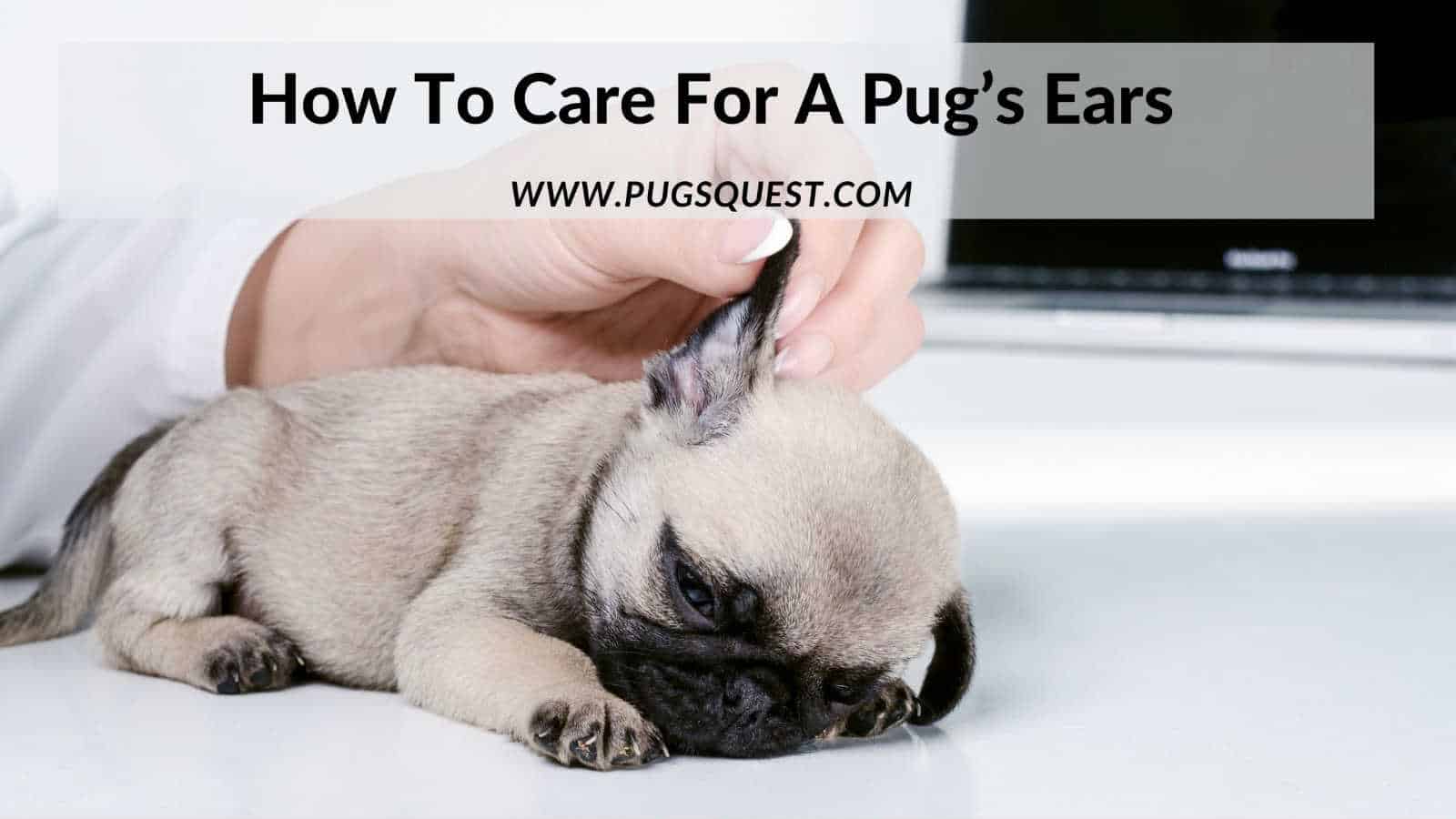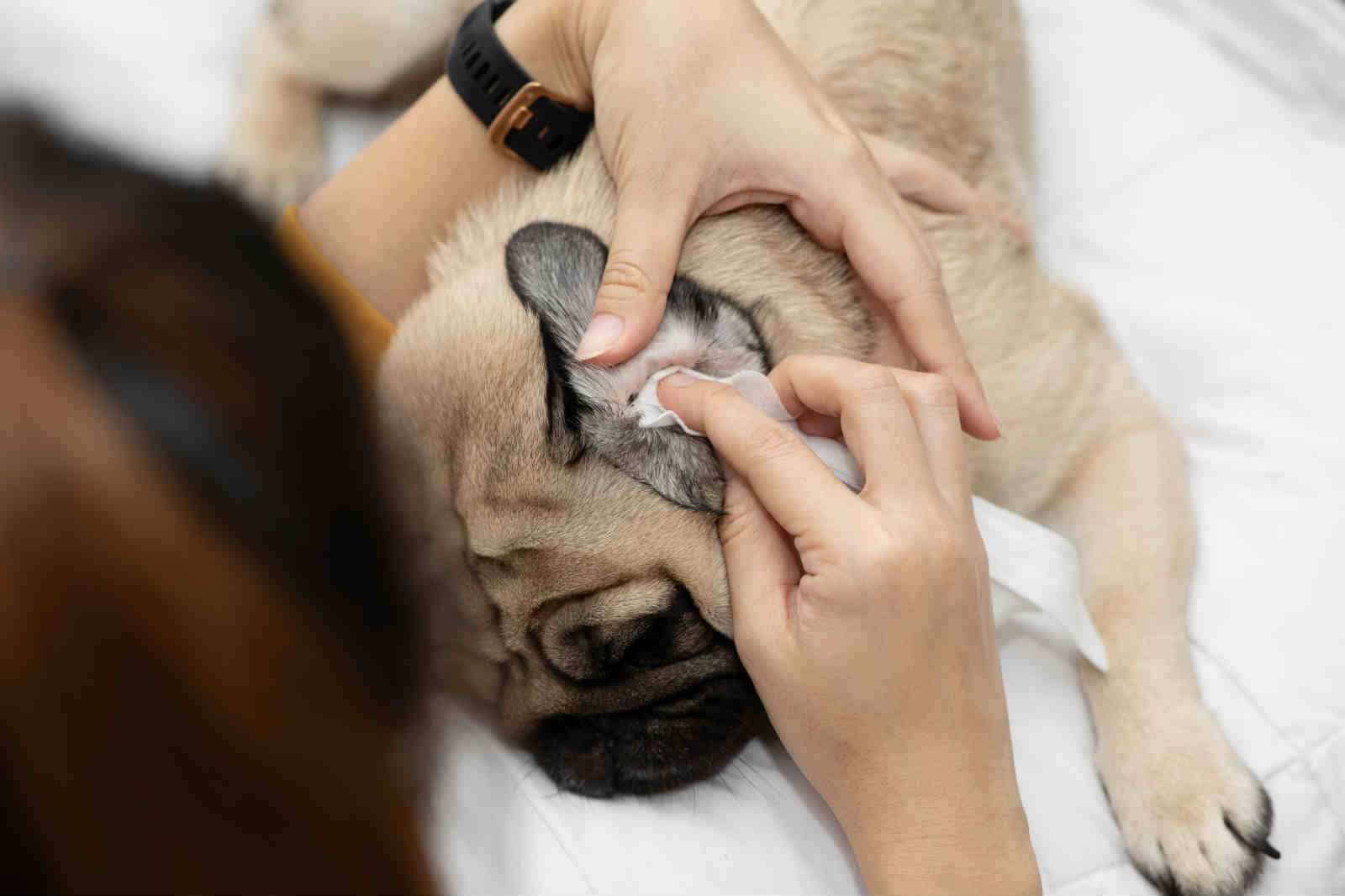
We need to clean Pugs’ ears regularly to maintain proper hygiene and prevent infection.
Don’t worry if you’re not too sure where to start.
We’re going to walk you through everything you need to know about protecting your Pugs ears from infection.
What Are Pug Ear Infections?
Just like us, Pugs can contract ear infections. In fact, ear infections are a common condition in many dog breeds. Ear infections can be very unpleasant and painful for your pet.
Luckily, most ear infections can be treated quite easily with a course of antibiotics.
There are three main types of ear infections.
- Otitis externa- an infection of the external lining of the ear canal
- Otitis media – an infection to the middle ear canal
- Otitis interna – and infection to the inner ear canal
The most common (and least severe) type of infection is Otitis externa. This is easily treated. Otitis media and interna, can be more damaging and sometimes even result in deafness and/ or partial paralysis to the face.
What Causes Pug Ear Infections?
Dogs of all breeds are prone to infection because of the way in which their ear canals are formed. A dog’s ear canal takes the form of an ‘L’ shape.
Unfortunately, that means that the ear canal can easily end up holding in excess fluids that lead to infection.
When fluids build up in the ear canal, bacteria and yeast propagate. As such, reducing the risk of infection requires Pug parents to be really diligent when it comes to their pet’s ear hygiene. That bacteria can quickly build up and lead to infection – which nobody wants.
In reality, there are many different possible causes of infection. These include:
- Moisture
- Allergies
- Thyroid disease
- Autoimmune disorders
- Ear mites
- Wax buildup
- Physical trauma
- Tumors or polyps
- Hormonal imbalance
- Foreign bodies
- Excessive cleaning
Signs and symptoms of ear infections in Pugs
The best way to treat an ear infection is to catch it early. And that means we need to know what signs and symptoms to look out for ahead of time.
Typical symptoms of ear infections in dogs vary depending on the severity and stage of infection. Since the infection is inside your dog’s ear, not all symptoms will be immediately obvious or visible.
In fact, some dogs won’t show any signs at all, until they are in a lot of pain. If in doubt, always visit your vet for a professional opinion.
Typical signs of infection include:
- Head tilting or shaking
- Rapid eye movement (nystagmus)
- Scratching the ear
- Difficulty eating
- Lack of balance
- Dark discharge
- Musty/ yeasty odor
- Redness in the ear canal
- Any display of pain/ discomfort
- Crusting/ scabbing in the ear
- Inability to blink (dry eye)
- Drooping eyelids on the affected side
In more severe cases, an ear infection can lead to a condition called Horner’s Syndrome.
Horner’s Syndrome is a neurological disorder of the eye and facial muscles that usually affects one side of the face (though sometimes both).
Diagnosing Pug Ear Infections
If your Pug starts to show any of the signs and symptoms listed above, it’s best to visit your vet for a professional diagnosis.
Catching an infection early is the best way to prevent its spread and any further damage the infection could end up causing your pet.
The vet will examine your Pugs’ ears, checking for mites, wax, and any rupturing to the eardrum.
They may also take a small biopsy, X-ray, or swab to check for bacteria, yeast, parasites, or tumors.
Finally, it’s also useful sometimes to check for allergies.
Treating Pug Ear Infections
First, thing’s first, your vet will clean out your Pug’s ear thoroughly. Your vet will then recommend a treatment plan depending on what is causing your Pug’s ear infection.
This could range from something very simple like a daily ear cleanser and topical medication to more aggressive treatments like antibiotics, anti-fungal, or anti-inflammatory medications.
If your vet does prescribe antibiotics you must complete the full course of treatment. Even if your Pug seems to be on the mend. Cutting a course of antibiotics short is counterproductive and can lead to the development of treatment-resistant infections in the future.
Now, be prepared. Because your Pug is not going to enjoy taking these medicines. Follow these top tips to make the process as stress-free as possible.
- Pair up – you might need reinforcements
- Stay calm – try to soothe your Pug with gentle cooing
- Position the syringe at the opening of your Pugs ear
- Gently massage the area
- Praise your pup and offer them a treat as a reward
In very severe cases, some dogs will require surgery. If your Pug’s ear infection is caused by a foreign body, polyp, or tumor then this may need surgical removal via a total ear canal ablation (TECA) which will remove any diseased tissue.
But don’t panic. This is very rare. With proper treatment, most ear infections will clear up within a couple of weeks. Your pet will be back to its normal, happy, self in no time.
Can Pug Ear Infections Be Prevented?
Yes. Although sometimes ear infections come about for reasons out of our control, we can prevent them with proper care.
A big part of preventing infection is observing a good hygiene routine. Below we’ll outline the ideal ear-care routine for you and your lovely pup.
This video will help you leave your Pug’s ears sparkling clean:
How to Care For Your Pug’s Ears
Cleaning your Pugs ears at home is a great way to prevent infection. Below you’ll find a step-by-step guide for keeping those ears squeaky clean and infection-free.
Step 1: Check the ears
The first thing you’ll want to do is check your pup’s ears for dirt, grime, and signs of infection.
Flip over those ear flaps and take a look. Healthy ears should be pinkish in color.
If you notice that your Pug’s inner ear looks red or inflamed then call your vet- they might have an ear infection already.
Look out for all the symptoms we discussed above. Any signs of infection and you should stop what you’re doing and call your vet.
Given your Pug the all-clear?
If your Pug’s ears look healthy then we can proceed to the next step.
Step 2: Clean the outer ear folds – 1x per week
Clean in and around the outer ear – not forgetting those folds and flaps.
You want to be removing all of that bacteria and debris to prevent infection. You could use a doggie wipe or a soft cotton pad with fresh, clean water. It’s totally up to you.
It’s really important to thoroughly dry the area afterward. Remember excess moisture becomes bacteria.
Step 3: Clear the inner ear canal – 1x per 6 weeks
Next, it’s time to delve a little deeper. You won’t need to clean the ear canal frequently, but it’s important to do this every six weeks or so.
We want to be breaking up any waxy buildup and removing all that accumulated debris and moisture.
Cleaning the ear canal is a delicate process and a bit more tricky than cleaning the outer ear.
Here are some top tips to help you through the process:
- Stay calm and go slow
- Lift the outer ear flap with one hand
- Use an ear solution and place a few drops into the ear canal
- Massage the base of the ear with your thumb for two to three minutes
- Use a dog-friendly ear wipe or cotton to clear away any debris that has come up into the outer ear canal area – you’ll probably notice some brownish-yellow gunk
- DO NOT venture too far into the ear canal – this could hurt your Pug
Once again remember to dry the area thoroughly before letting your Pug go. We want to prevent as much excess moisture from lingering in the ear as possible.
Now, give your patient (or not so patient) pal a treat!
Care For A Pug’s Ears
I hope this guide could help you know about caring for your Pugs’ ears.
With regular cleaning and TLC, you’ll prevent infection and keep your Pug fighting fit.
Remember, if you do notice Pug ear infections are beyond your control, call your vet. The faster you seek treatment, the better the outcome.

